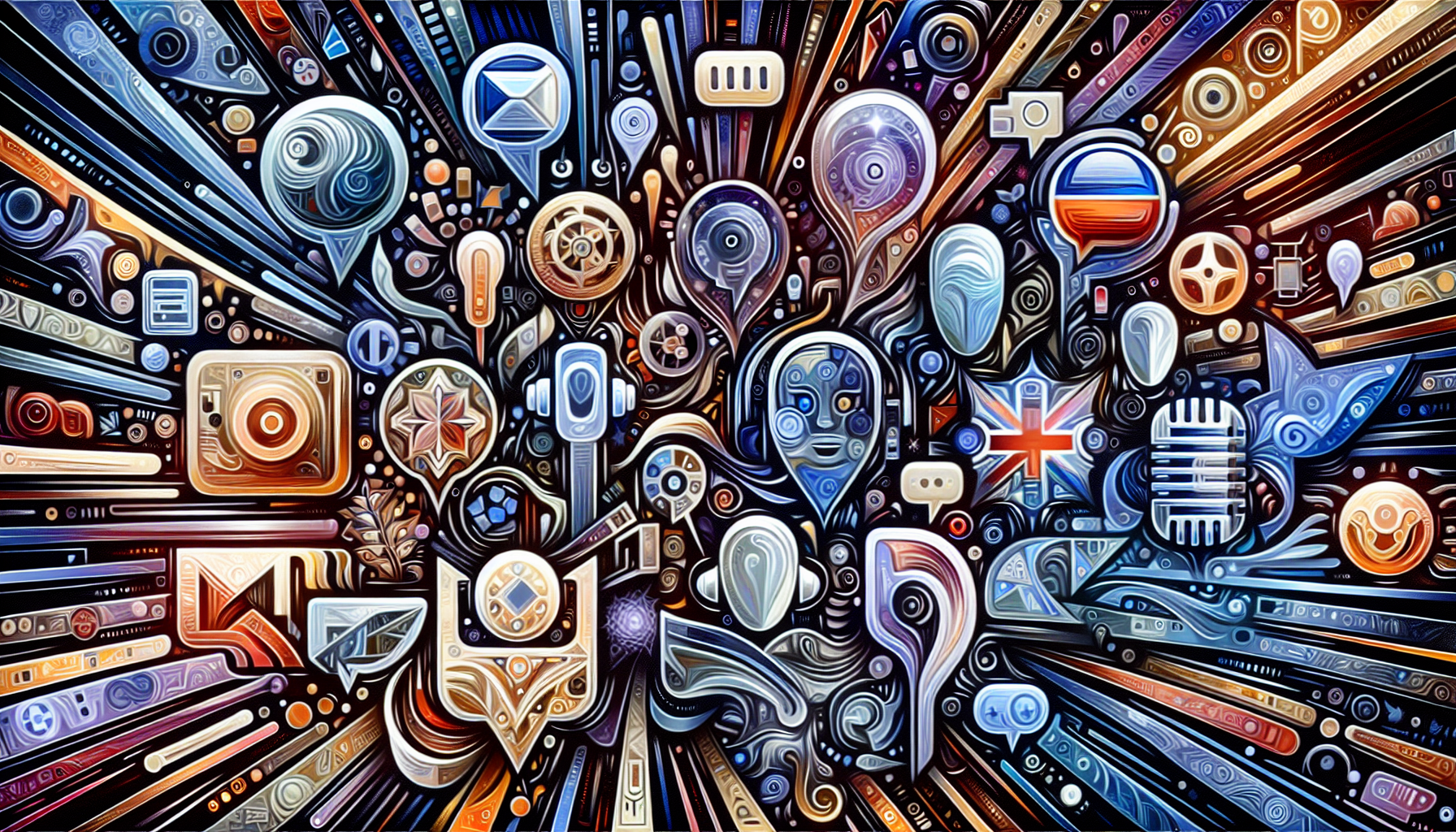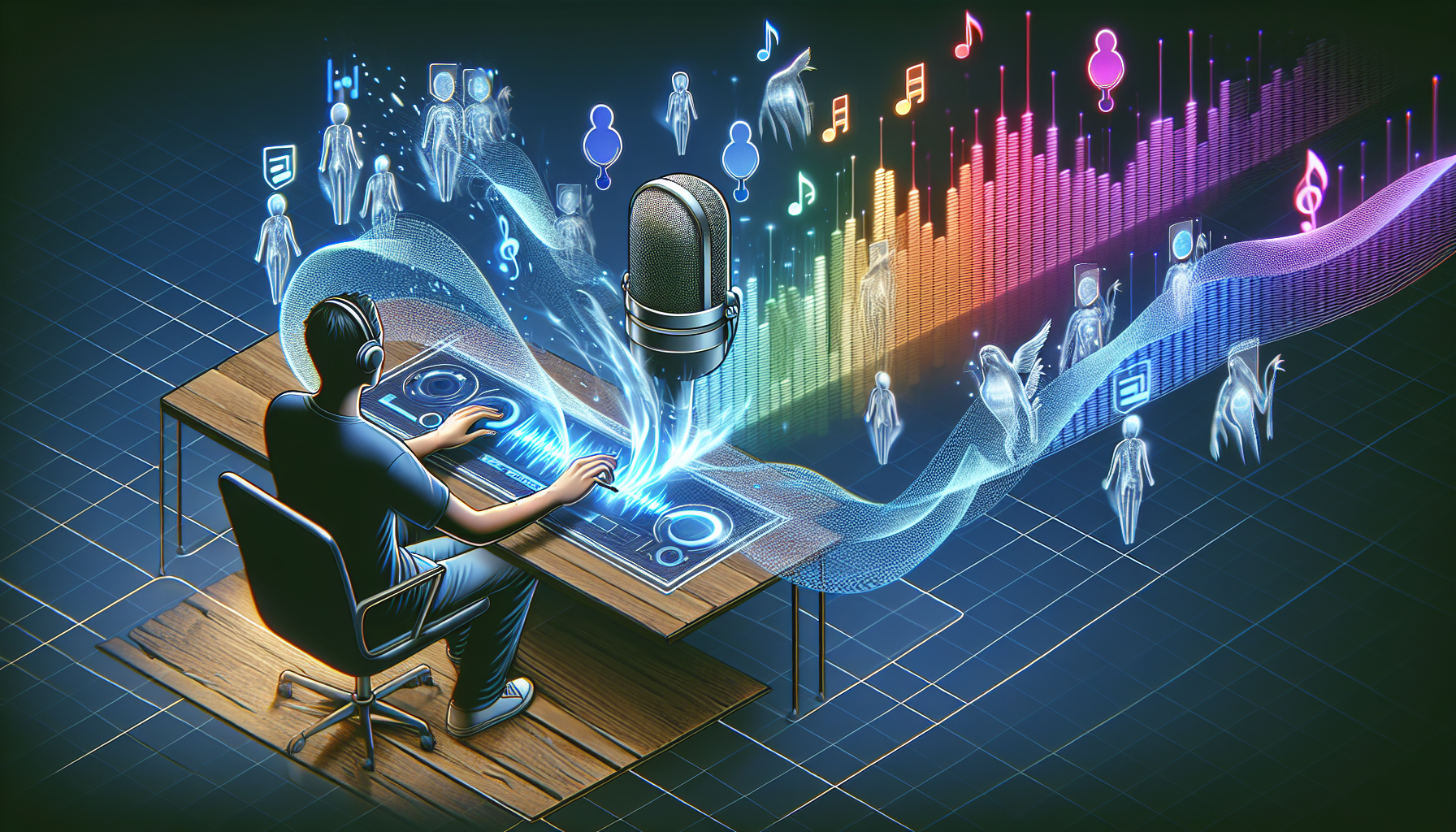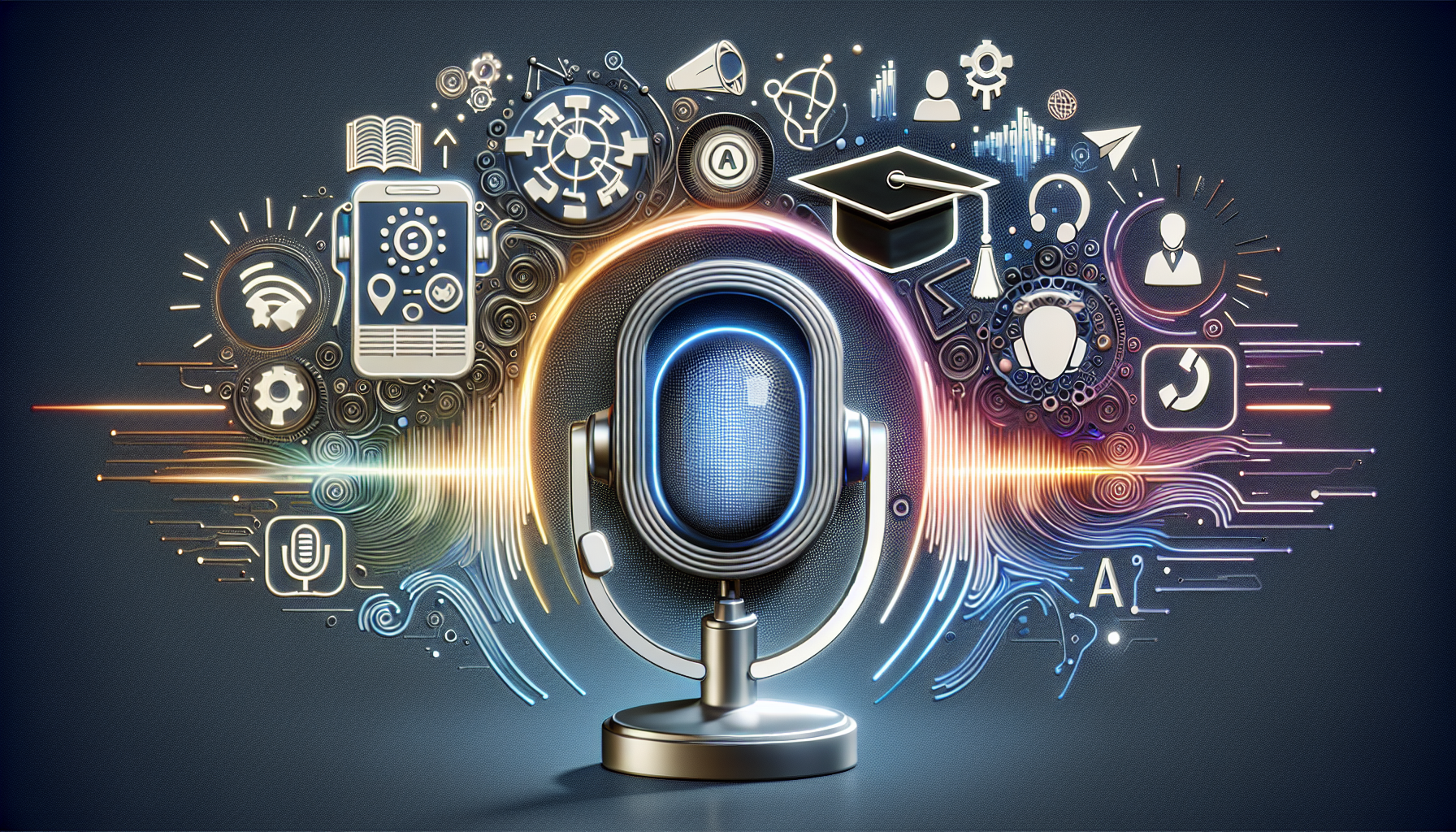Paul
May 17, 2024
Table of Contents |
AI text-to-voice technology is reshaping our interpretation of written content by providing vocals that closely mimic human speech. Discover the simplicity behind the technology, explore its wide range of applications, and learn about its benefits for content creators and everyday users alike, all within our easy-to-follow guide.
Key Takeaways
- AI text to voice technology generates real-time, natural and human-like speech, allowing for voice customization and enhancement of listener experiences.
- Advancements in AI and voice cloning technology enable the creation of unique, personalized voices with the potential to support over 100 languages and various accents, expanding global accessibility.
- AI-generated voices offer diverse applications across industries such as enhancing customer service through conversational AI, revitalizing educational content, ensuring accessibility, and enabling creative expression in music and art.
What is AI Text to Voice?

Welcome to the world of AI text to voice, where technology meets creativity to produce voices so real you can’t tell they’re not human. Text-to-speech (TTS) or speech synthesis is the technology that allows computer programs to convert written text into speech in real-time. But it’s not just about converting text into speech. It’s about doing it in a way that sounds natural and human-like to the listener.
Converting text to audio with AI is easy. Here’s how:
- Choose a voice
- Customize as needed
- Enter text into the tool
- Get natural sounding speech
Imagine having a button to get human-like voices! That’s the power of AI text to voice.
AI innovations have reduced the robotic tone of speech synthesis making AI voice generators produce more realistic and human-like speech. Whether you’re a content creator looking to boost your audio projects or a business looking to improve customer interactions, AI text to voice is a solution that’s not only works but also fun.
So the future is bright. 🌟👏🏼🔥🎉
AI Generated Voice Sound
AI-generated voice sounds are distinguished by their natural intonation and rhythm, which are crucial for making them nearly indistinguishable from human speech. Platforms like Lovo.ai have been recognized for producing highly realistic AI voices, valued for their lifelike speech and accurate pronunciations. From fine-tuning elements such as rate, pitch, emphasis, and pauses to exhibiting expressive emotional speaking styles, AI voice generation technologies offer a wide spectrum of customization options.
Such detailed control facilitates the generation of AI voices that sound natural and emotionally connect with the listener.
Speech Synthesis Breakthroughs
"AI voice generators have reached a level of realism where the generated speech is nearly indistinguishable from human voices, offering a truly engaging listener experience.
Musicians Institute
Recent breakthroughs in AI have significantly enhanced the quality of speech synthesis, leading to advanced AI voices that are almost indistinguishable from human speech. AI voice generators now offer a diverse range of voice profiles capable of conveying a wide spectrum of emotions.
These advancements have elevated the quality of AI voices and expanded their application range, rendering them a vital tool for content creators, businesses, and educators.
From Text to Audio: How AI Voices Work
But how does text get transformed into such natural-sounding AI voices? The answer lies in the advanced algorithms used in AI speech synthesis. These algorithms interpret formatted text and adjust tone based on context, resulting in speech that closely mimics human speech patterns.
The outcome is a smooth conversion of text into near-human audio, signifying a significant advancement in the evolution of AI-generated voices.
Custom AI Voices

The wonder of AI text to voice technology goes beyond the generation of human-like voices. It also allows the creation of unique synthetic voices, tailored to individual needs and preferences. Some AI platforms enable users to create new and unique synthetic voices rapidly. With just one minute of audio, their voice cloning technology can design custom voices.
The outcome? A voice that genuinely represents your unique personality and style.
Voice Cloning Magic
Voice cloning technology is truly magical, enabling the creation of unique voices by analyzing samples of real human speech and reproducing them through AI models. AI voice cloning software captures specific acoustic traits of a voice during feature extraction and uses neural network models to replicate those speech patterns and nuances. The accuracy of the cloned voice improves with the amount of voice data available, as the AI system can better learn the voice’s characteristics.
This technology enables personalized voice-overs with AI tools, allowing users to record their voice and formulate a custom voice TTS model for diverse applications.
Personalizing Your Digital Voice
Personalization is at the heart of AI-generated voices. Lalals’ text-to-speech application, for instance, allows users to personalize AI voices through adjustments to accents, languages, and speech speed, facilitating a customized speaking style. Users can utilize the ‘Pitch’ feature to control the tone of the AI voice, tailoring it to suit a variety of applications ranging from simple narrations to complex character dialogues.
Whether it’s changing your voice into the vocals of the best artists or transforming your voice into that of a celebrity, the possibilities with AI voice personalization are endless.
The Global Reach of Multilingual AI Voices
AI voice generators extend beyond personalization to inclusivity and global reach. In the quest for the best AI voice generator, it’s important to note that these platforms now support 100+ languages, with options expanding all the way to 90 distinct voices encompassing a range of accents worldwide. These AI platforms not only cover a broad spectrum of languages including popular ones such as Portuguese and Italian but also ensure that the voices have native-sounding accents.
With voice cloning technology, we can create uniform voice tones and styles for diverse language projects, broadening the reach to international audiences.
Professional Voiceovers Made Easy

Visualize producing professional voiceovers with a mere few clicks. That’s the power of AI text to speech technology. Platforms like:
- Lalals.com
- Amazon Polly
- Microsoft Azure Text to Speech
- TikTok Text-to-Speech
- Google Text-to-Speech
offer AI voiceover tools for commercial purposes. These tools allow the creation of human-quality voiceovers in real-time, which can be further enhanced by providing realistic-sounding voiceovers across different ages, languages, and accents with an easy-to-use interface.
Effortless Creation of Audio Projects
AI text to voice applications streamline the process of creating audio projects. They can be easily installed on various devices or added as browser extensions to facilitate the transformation of text into speech. Features like preview mode allow users to listen and preview a single paragraph or the full text prior to conversion, ensuring satisfaction with the end result.
With the flexibility of adjusting the speaker’s timing by clicking and dragging the clips, AI text to voice applications not only make voiceover production easier but also more efficient.
Consistent Quality Across Productions
Consistent quality is one of the primary advantages of AI-generated voiceovers. Advanced text to speech technology enables the production of consistent quality voiceovers, closely imitating human speech patterns. Regardless of the script’s length or complexity, the output remains uniformly high in quality, ensuring professional standards are met.
Maintaining this consistent quality is beneficial for diverse audio projects, ensuring a professional and engaging listening experience every time.
Speedy Delivery with AI Text to Speech
❓ Did you know❓
AI text-to-voice technology can convert text into speech almost instantaneously?
Another major benefit of AI text to speech technology is speed. Text to speech software can quickly convert a wide range of written material into audio. This reduces production times for tasks like creating audiobooks. It can generate natural-sounding speech fast for immediate voiceover work. It also produces audio for social media platforms that need fresh content regularly. AI text to speech supports many languages, accents, and genders. It offers various voice styles for different applications. This caters to a global audience with unique needs.
AI Text to Voice Applications

Enhancing User Experience with Conversational AI
AI text to voice technology is not confined to only producing natural-sounding voices. Its versatility extends to various industries and applications, from customer service to education and accessibility. Interactive Voice Response (IVR) systems enhanced with Text-to-Speech (TTS) technology offer an efficient and cost-effective solution for businesses to handle customer inquiries.
The AI text to voice technology supports over 120 text to speech voices in more than 20 languages, enabling the creation of multi-lingual content.
Conversational AI is revolutionizing customer service by providing human-like interactions through advanced AI-generated voices. Some benefits of using AI-generated voices in chatbots include:
- Improved customer interactions
- More natural and engaging conversations
- Increased customer satisfaction
- Enhanced brand image
Customer interactions via chatbots are greatly improved when the chatbots are equipped with AI-generated voices that mimic natural human speech.
Educational Content Comes to Life
AI-generated voices are also bringing educational content to life. AI text-to-speech generators quickly convert text-based educational materials into audio for eLearning and explainer videos. They offer various voices and languages to enhance learning comprehension and retention. These generators support diverse narration styles and make audiobook production more accessible and cost-effective, creating engaging and immersive educational experiences.
Summary
AI text-to-voice technology, also known as text-to-speech (TTS), is transforming how we interact with digital content. It makes written material more accessible and engaging with realistic, human-like audio. This technology simplifies converting text into spoken word. It also enhances the user experience by providing natural and dynamic vocalizations. Content creators use it to enhance multimedia projects. Businesses use it to improve customer service and make educational materials more interactive. The applications of AI voice technology are broad and diverse.
Additionally, the development of voice cloning and personalization features allows AI voices to be tailored to specific needs and preferences. This makes digital interactions more personal and effective. The technology’s multilingual capabilities extend its accessibility. It lets content resonate with a wider audience across various linguistic and cultural backgrounds. Advancements in AI and voice synthesis technology continue to grow. They hold the potential for creating more refined, expressive, and versatile vocal experiences. AI text-to-voice technology is reshaping our digital world. It is paving the way for a future where digital communication is more inclusive, engaging, and centered around human interaction.
Frequently Asked Questions
All you need to know about Lalals.
What is AI text-to-voice technology?AI text-to-voice technology, or text-to-speech (TTS), uses artificial intelligence to convert text into natural, human-like spoken words, with customizable voice options. |
How can AI text-to-voice be used across different industries?The technology is used to enhance customer service with conversational AI, support educational content in eLearning, enable creative expression, and improve accessibility. |
What are the customization options available in AI text-to-voice technology?Users can adjust voice pitch, speed, and accent. Advanced settings include rate, pitch, emphasis, and creating unique voices through voice cloning. |
Can AI text-to-voice support multiple languages and accents?Yes, it supports over 100 languages and various accents, enhancing global reach and inclusivity. |
What future advancements can be expected in AI text-to-voice technology?Future advancements will focus on increasing the realism and expressiveness of synthesized speech, further enhancing the quality and versatility of AI-generated voices. |
Convert Your Voice with AI
Make your voice sound like those of famous arists.
Join Lalals and use our hyper-realistic voice converter now.